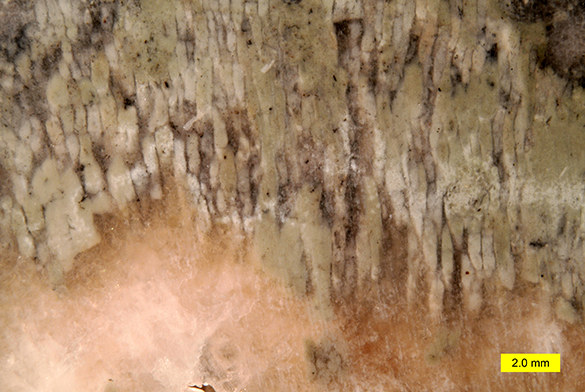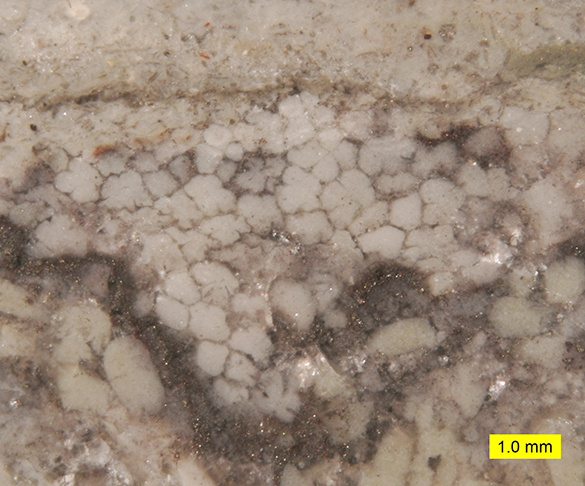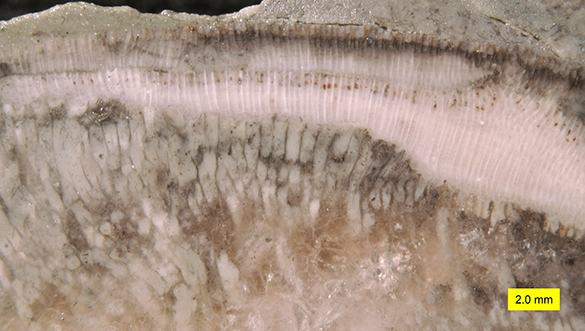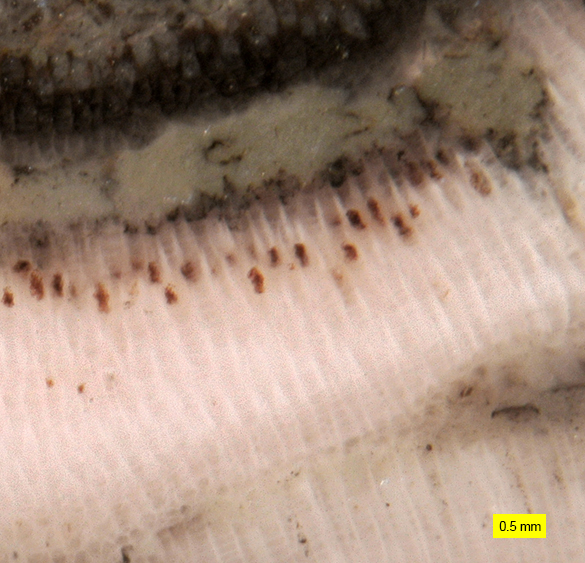 Last week we looked at a dull gray rock found in a roadcut in southeastern Indiana near the town of Liberty. It is from the Saluda Formation (Upper Ordovician), a thin unit that was likely deposited in very shallow, lagoonal waters along the Cincinnati Arch. We know that it is primarily a platter formed by the mysterious fossil Tetradium, and that it is encrusted with a trepostome bryozoan that was infested by some sort of soft-bodied encruster on its surface, forming the trace fossil Catellocaula vallata. Now we’re examining the wonders revealed by cutting this rock in half. Above we see the surprising and spectacular geode that it is, with calcite crystals surrounding a dark cavity. Let’s see what the fossils look like when polished and magnified.
Last week we looked at a dull gray rock found in a roadcut in southeastern Indiana near the town of Liberty. It is from the Saluda Formation (Upper Ordovician), a thin unit that was likely deposited in very shallow, lagoonal waters along the Cincinnati Arch. We know that it is primarily a platter formed by the mysterious fossil Tetradium, and that it is encrusted with a trepostome bryozoan that was infested by some sort of soft-bodied encruster on its surface, forming the trace fossil Catellocaula vallata. Now we’re examining the wonders revealed by cutting this rock in half. Above we see the surprising and spectacular geode that it is, with calcite crystals surrounding a dark cavity. Let’s see what the fossils look like when polished and magnified.
 The orangish, irregular patch in the lower half of the section above is the crystalline calcite near the center of the rock. The sediment-filled tubes in the top half are of the Tetradium specimen. Note that the walls of the tubes are blurry and indistinct, and that they fade and disappear into the calcite crystals below. This is apparently because the skeleton of Tetradium was made of aragonite, an unstable form of calcium carbonate. It is likely that the aragonitc, tubular skeleton of Tetradium dissolved away in the center of this encrusted mass, forming the cavity that later filled with secondary calcite crystals. The remaining tubes were apparently preserved as ghostly molds by infillings of calcitic mud that didn’t dissolve.
The orangish, irregular patch in the lower half of the section above is the crystalline calcite near the center of the rock. The sediment-filled tubes in the top half are of the Tetradium specimen. Note that the walls of the tubes are blurry and indistinct, and that they fade and disappear into the calcite crystals below. This is apparently because the skeleton of Tetradium was made of aragonite, an unstable form of calcium carbonate. It is likely that the aragonitc, tubular skeleton of Tetradium dissolved away in the center of this encrusted mass, forming the cavity that later filled with secondary calcite crystals. The remaining tubes were apparently preserved as ghostly molds by infillings of calcitic mud that didn’t dissolve.
 In this section we are cutting the Tetradium tubes perpendicularly, rather than the longitudinal cuts we saw before. The cross-sections of the tubes show a four-part symmetry, which adds to the mystery of this group. (This is where the name “Tetradium” comes from.) It has been called a chaetetid sponge (as in Termier and Termier, 1980); a “calcareous filamentous florideophyte [red] alga” (Steele-Petrovich 2009a, 2009b, 2011; she renamed it Prismostylus), and most commonly a coral of some sort (as in Wendt, 1989). I now know enough about chaetetids to say that it is not in that group. Chaetetid tubes are not aragonitic, do not show tetrameral symmetry, and have diaphragms (horizontal floors). The corals of the Ordovician are decidedly calcitic, not aragonitic, and they too have internal features in their tubes not seen here. The four-part symmetry, though, is something you see in the coral’s phylum, Cnidaria, so there is that vague resemblance. The red algal affinity strongly urged by Steele-Petrovich may be our best diagnosis for the place of Tetradium.
In this section we are cutting the Tetradium tubes perpendicularly, rather than the longitudinal cuts we saw before. The cross-sections of the tubes show a four-part symmetry, which adds to the mystery of this group. (This is where the name “Tetradium” comes from.) It has been called a chaetetid sponge (as in Termier and Termier, 1980); a “calcareous filamentous florideophyte [red] alga” (Steele-Petrovich 2009a, 2009b, 2011; she renamed it Prismostylus), and most commonly a coral of some sort (as in Wendt, 1989). I now know enough about chaetetids to say that it is not in that group. Chaetetid tubes are not aragonitic, do not show tetrameral symmetry, and have diaphragms (horizontal floors). The corals of the Ordovician are decidedly calcitic, not aragonitic, and they too have internal features in their tubes not seen here. The four-part symmetry, though, is something you see in the coral’s phylum, Cnidaria, so there is that vague resemblance. The red algal affinity strongly urged by Steele-Petrovich may be our best diagnosis for the place of Tetradium.
 On top of the tubes of Tetradium is the encrusting trepostome bryozoan. Its tubes (zooecia) are made of stable calcite, so they are well preserved compared to the aragonite tubes of Tetradium below it. Note that the bryozoan is made of two layers. One colony died or went into some sort of remission, and another of the same species grew across it. The second colony could have budded somewhere from the first colony.
On top of the tubes of Tetradium is the encrusting trepostome bryozoan. Its tubes (zooecia) are made of stable calcite, so they are well preserved compared to the aragonite tubes of Tetradium below it. Note that the bryozoan is made of two layers. One colony died or went into some sort of remission, and another of the same species grew across it. The second colony could have budded somewhere from the first colony.
 This closer view of the bryozoan section shows details of the zooecia, including the horizontal diaphragms inside. The dark spots at the tops of the zooecia are brown bodies, the remains of polypides preserved here in clear calcite cement. (We’ve seen brown bodies before in this blog.) They likely represent some sort of traumatic event in the life of this bryozoan when this part of the colony essentially shut down and was covered with sediment.
This closer view of the bryozoan section shows details of the zooecia, including the horizontal diaphragms inside. The dark spots at the tops of the zooecia are brown bodies, the remains of polypides preserved here in clear calcite cement. (We’ve seen brown bodies before in this blog.) They likely represent some sort of traumatic event in the life of this bryozoan when this part of the colony essentially shut down and was covered with sediment.
 Finally, there is a mineralogy story here too! Attached to the dog-tooth calcite spar in the center of this geode is this tiny gypsum flower. The gypsum crystals are white and very delicate. The dark needles among them are mysterious. Dr. Meagen Pollock and her students will subject them to x-ray diffraction in her lab later this semester. I’ll report the results here.
Finally, there is a mineralogy story here too! Attached to the dog-tooth calcite spar in the center of this geode is this tiny gypsum flower. The gypsum crystals are white and very delicate. The dark needles among them are mysterious. Dr. Meagen Pollock and her students will subject them to x-ray diffraction in her lab later this semester. I’ll report the results here.
It is a simple tool, the rock saw. For geologists and paleontologists, it is one of our essential instruments for discovery.
References:
Hatfield, C.B. 1968. Stratigraphy and paleoecology of the Saluda Formation (Cincinnatian) in Indiana, Ohio, and Kentucky. Geological Society of America Special Papers 95: 1-30.
Li, Q., Li, Y. and Kiessling, W. 2015. The first sphinctozoan-bearing reef from an Ordovician back-arc basin. Facies 61: 1-9.
Palmer, T.J. and Wilson, M.A. 1988. Parasitism of Ordovician bryozoans and the origin of pseudoborings. Palaeontology 31: 939-949.
Steele‐Petrovich, H M. 2009a. The biological reconstruction of Tetradium Dana, 1846. Lethaia 42: 297-311.
Steele‐Petrovich, H M. 2009b. Biological affinity, phenotypic variation and palaeoecology of Tetradium Dana, 1846. Lethaia 42: 383-392.
Steele-Petrovich, H.M. 2011. Replacement name for Tetradium DANA, 1846. Journal of Paleontology 85: 802–803.
Termier, G. and Termier, H. 1980. Functional morphology and systematic position of tabulatomorphs. Acta Palaeontologica Polonica 25: 419-428.
Wendt, J. 1989. Tetradiidae — first evidence of aragonitic mineralogy in tabulate corals. Paläontologische Zeitschrift 63: 177–181.































































